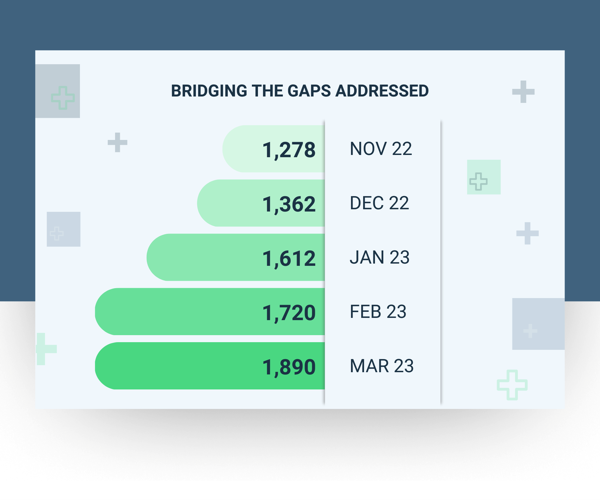How Chronic Care Management Helps with Social Determinants of Health
Social Determinants of Health (SDOH), the environmental and economic factors that affect people’s well-being, have dramatic impacts on long-term health. A study by the Office of Health Policy found that SDOH account for 50% of county-level variations in health outcomes.
In a Chronic Care Management (CCM) program, care managers speak to patients monthly, which offers them abundant opportunities to learn about patients’ environments and provide resources to address unmet needs.
Here are six different types of Social Determinants of Health and how CCM staff can help providers address them.
What Are the 6 Social Determinants of Health?
The KFF Office of Racial Equity and Health Policy divides Social Determinants of Health into six categories. Looking more closely at these categories can help us understand how social factors affect the health of patients.
Economic Stability
Economic stability relates to a person’s ability to meet their basic needs with their income. In 2021, 37.9 million Americans fell below the poverty line. Those living in poverty may face housing instability or the inability to pay for other basic needs, like utilities and food. Lacking clean water, heat and AC, or shelter from weather can have a devastating impact on a person’s health.
- If care managers realize a patient is facing housing instability, they can direct patients to local nonprofits that assist with housing and paying utilities.
Food
Families faced with food insecurity often have to prioritize the most caloric value for the lowest cost. They’re forced to turn to cheap, processed food instead of expensive fresh produce.
23.5 million people also live in food deserts–areas where a supermarket is more than 1 mile away (in an urban area) or more than 10 miles away (in a rural area.) People who don’t have a car or can’t afford gas often can’t travel that distance.
- When CCM care managers hear about food insecurity, they can recommend local food pantries and free or low-cost food delivery services.
Education
When a person grows up with access to quality education, they have the foundation to explore higher education opportunities and find well-paying jobs with stable income.
Those with less than a high school diploma experience an 8.3% unemployment rate and make nearly $200 less per week than high school graduates. But a child who grows up in a low-income area is more likely to end up in an underfunded public school, and that lack of funding makes them less likely to perform well on tests or graduate high school.
Healthcare System
Shortages of care providers and lack of insurance coverage may prevent individuals from getting the care they need.
Without adequate health coverage, individuals are less likely to see a primary care provider or to have their chronic illnesses treated early, before they lead to major declines in health.
Many rural areas also suffer from a lack of providers. The patient-to-primary care physician ratio in rural locations is 39.8 physicians per 100,000 people, while the ratio in urban areas is 53.3 physicians to every 100,000.
- CCM services can check on whether Medicare patients are attending their appointments and arrange transportation services if that presents a barrier.
Neighborhood and Physical Environment
Living in an area with high rates of violent crime or pollution can dramatically affect a person’s health. A person may experience violence personally, which impacts their physical and mental health, or witness it surrounding them, which still impacts their mental health.
Environmental conditions play a major role in health outcomes as well. Contaminated water and polluted air can lead to cancer, lung diseases, and other devastating health effects.
Community and Social Context
Social and community context refers to friends, family, coworkers, and community groups. Studies on the connection between community and self-rated health show that those living in weaker communities often have poorer mental and physical health.
- If care managers realize a person is struggling with loneliness, they can connect them with local volunteer organizations, senior centers, or exercise groups like Silver Sneakers.
How Can Chronic Care Management Help?
Because Chronic Care Management staff reach out to patients every month, they can perform SDOH screenings during their regularly scheduled touchpoints. In the first quarter of 2023, the ChartSpan CCM team performed 5,222 SDOH screenings.

While CCM staff may not be able to resolve all SDOH concerns, they can connect their patients with resources to help them meet their needs.
For example, a member of our clinical team shared the following story of working with a patient:
During our call, the patient and I were going through the Social Determinants questions and I learned that she sometimes had difficulty getting to appointments due to transportation. She had suffered a brain injury that would give her severe headaches and she would not feel safe driving and her husband was not always in a condition to drive either. I helped her find transportation assistance in her area and also reminded her that we were here to assist her if she needed it.
Another clinical team member spoke of helping a patient with dietary needs:
Ms. X performed our Social Determinants Assessment and revealed that she had some food insecurities. She declined assistance with food pantries and meal delivery services because she did not like the quality of food offered, stating it was canned and processed and did not follow her dietary guidelines. I found her a resource for fresh food boxes delivered to her home, where the food was locally grown and sourced.
By addressing Social Determinants of Health and offering resources, CCM teams can help patients manage their long-term health and achieve better outcomes.
Learn More about Chronic Care Management and SDOH
To improve patient health, providers have to consider the impact of SDOH. Chronic Care Management can’t remove the challenges of economic inequality, but it can provide patients with essential resources. If you’d like to learn more about Social Determinants of Health and CCM, check out our in-depth SDOH breakdown.


















